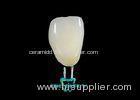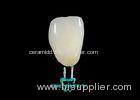Zirconia Dental Implants Crowns with Crown- Europe serials
Pre-sintered zirconia is prepared by three main steps
The zirconia powder is pressed and presintered. This is usually done by the manufacturer.
The dental lab mills the pre-sintered blank and then sinters the coping or framework to achieve full density.
Preparation of the pre-sintered blanks by the manufacturer differs depending on the zirconia powder source and both the pressing and the pre-sintering conditions selected.
1.Powder. The available zirconia powders can have different grain sizes, different distributions of the various grain sizes, and different additives (e.g. binder for the pressing step). The additives yttrium oxide and alumina can be distributed within the
material in a variety of ways, such as a homogene-ous distribution throughout the whole material, higher concentration at grain borders, etc. The grain size has an effect on strength and transformation toughening – a special and key mechanical
characteristic of zirconia. Variations in grain size distribution affect the resulting porosity and hence the translucency of the material. The distribution of additives can affect the hydrothermal stability of the sintered material.
Note: Differences in the zirconia powder affect the strength/long-term stability and translucency of the abutment.

2. Pressing conditions. The powder is first pressed, which can be accomplished by different procedures (e.g. isostatically or axially). The pressing conditions are adjusted to get an optimized blank for the pre-sintering step. The pressing methodology influences the homogeneity and the density distribution of the material and hence the marginal fit. The pressing conditions can lead to differences in
strength and translucency and affect the final sintering temperature of the zirconia
Note: The pressing condition and pressing method affect the marginal fit, strength, and translucency of the restoration.
3. Pre-sintering. The pressed zirconia powder is then pre-sintered in a furnace with an optimized temperature profile to generate a blank with suitable strength and millability.
Note: Pre-sintering conditions affect the strength of the pre-sintered material and its millability.
4. Coloring. Some zirconia materials can be colored in the pre-sintered state by immersing the copings,abutments, and frameworks in a dyeing liquid. This
enables the absorption of coloring agents in the zirconia material. Coloring can be achieved either by pigments (grains) or non-pigmented (ions)agents.
It is important to control the effect of thedyeing liquid on the mechanical characteristics ofthe zirconia material.
Note: Coloring of the zirconia can affect the marginal fit, strength, and translucency of the material.
In summary, the zirconia used in dentistry is chemically similar but not necessarily alike.








